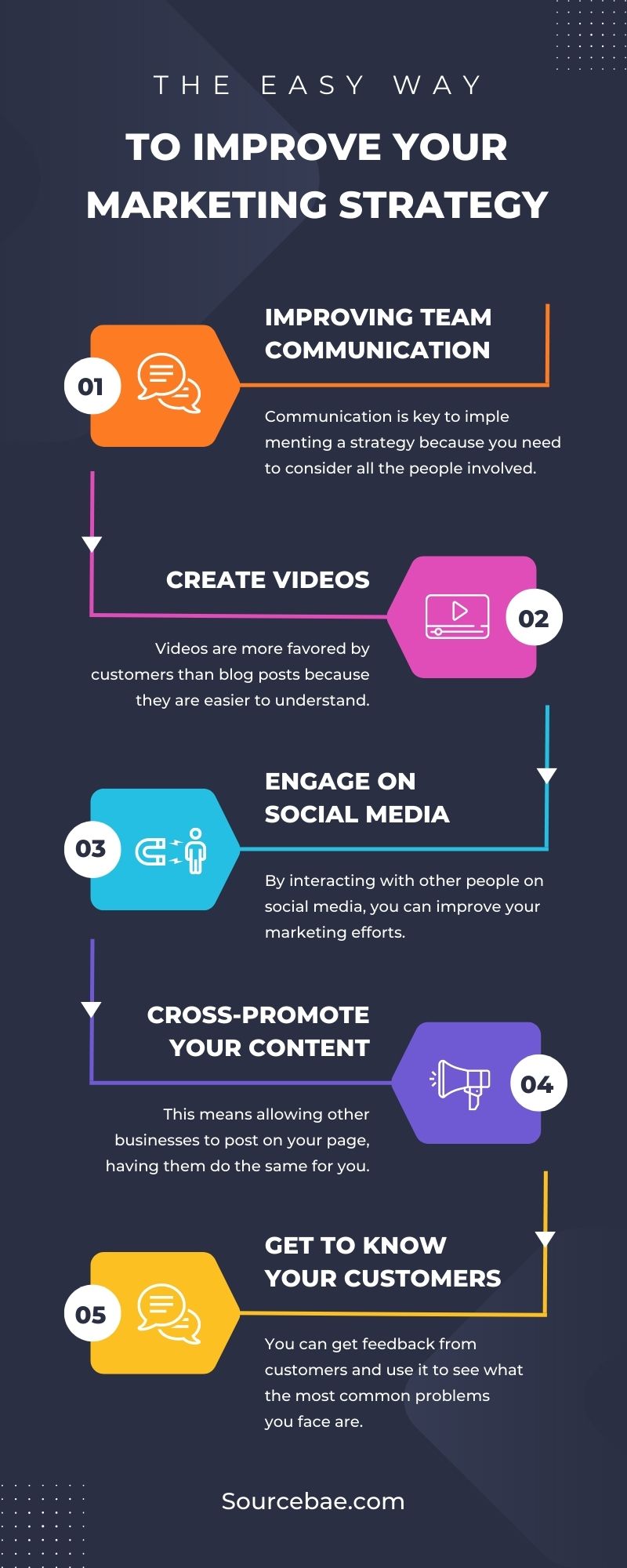In the fast-paced world of business, a strong marketing strategy can make all the difference. It’s the key to reaching your target audience, building brand awareness, and driving sales.
But with the ever-evolving landscape of digital marketing, how can you ensure your strategy is effective? Look no further!
In this comprehensive guide, we’ll explore the easy way to improve your marketing strategy, providing you with expert tips and insights to elevate your brand’s presence and drive success.
The Easy Way to Improve Your Marketing Strategy

A successful marketing strategy encompasses a range of elements, from content creation to audience targeting. By implementing the following tactics, you’ll witness a positive transformation in your marketing efforts:
1. Define Clear Goals and Objectives
To kick-start your marketing strategy enhancement journey, set clear and achievable goals. Whether it’s increasing website traffic, boosting sales, or expanding your social media following, well-defined objectives provide direction and purpose.
2. Conduct Thorough Market Research
Incorporate thorough market research to understand your audience’s needs, preferences, and pain points. This data-driven approach ensures your marketing efforts are aligned with your target demographic.
3. Craft Compelling Content
Content remains king in the digital realm. Create valuable and engaging content that resonates with your audience. From blog posts to videos, each piece should offer something meaningful to your readers or viewers.
4. Leverage Social Media Platforms
Incorporate social media platforms into your strategy. These channels provide a direct line of communication with your audience, allowing you to showcase your brand’s personality and build a loyal community.
5. Optimize for SEO
Search Engine Optimization (SEO) is a powerful tool to increase your brand’s visibility online. Incorporate relevant keywords, create high-quality backlinks, and ensure your website is optimized for search engines.
6. Embrace Email Marketing
Email marketing remains one of the most effective ways to connect with your audience. Build a subscriber list and send targeted, personalized emails to nurture leads and drive conversions.
7. Analyze and Adapt
Regularly analyze your marketing efforts to gauge their effectiveness. Use analytics tools to track metrics such as website traffic, conversion rates, and social media engagement. Adapt your strategy based on the insights gained.
8. Collaborate with Influencers
Partnering with influencers in your industry can exponentially expand your brand’s reach. Identify key influencers and collaborate on content that aligns with your brand’s values and goals.
9. Invest in Paid Advertising
While organic efforts are valuable, consider investing in paid advertising to reach a larger audience quickly. Platforms like Google Ads and social media ads allow you to target specific demographics.
10. Foster Customer Relationships
Prioritize customer relationships by providing exceptional customer service and engaging with your audience on social media. Loyal customers can become brand advocates, driving word-of-mouth promotion.
Expert Insights and Tips
To further enhance your marketing strategy, we reached out to industry experts for their insights:
“Consistency is Key” – Jane Smith, Marketing Guru
Jane Smith emphasizes the importance of maintaining consistency across all marketing channels. From your website’s design to your social media posts, a consistent brand image builds trust and recognition.
“Personalization Drives Engagement” – Mark Johnson, Digital Strategist
Mark Johnson suggests personalizing your marketing efforts to cater to individual customer preferences. Personalized content and recommendations show your audience that you value their unique needs.
FAQs
How can I improve my marketing strategy quickly?
Implement quick wins like optimizing your website’s loading speed, enhancing your social media profiles, and repurposing existing content for different platforms.
What role does storytelling play in marketing?
Storytelling creates an emotional connection between your brand and your audience. It helps convey your brand’s values and mission in a relatable and engaging manner.
Are there any budget-friendly marketing strategies?
Absolutely! Content marketing, social media engagement, and email marketing are cost-effective strategies that yield excellent results.
Should I focus more on digital marketing or traditional methods?
Both have their merits, but the digital landscape offers more immediate and measurable results. It’s advisable to allocate resources to digital marketing while considering traditional methods based on your target audience.
How often should I update my marketing strategy?
Regular updates are essential to keep up with industry trends and consumer behavior. Conduct quarterly reviews and make necessary adjustments to ensure your strategy remains effective.
Is video marketing worth the investment?
Video marketing is incredibly valuable in today’s digital age. It captures attention, delivers information effectively, and can be repurposed across various platforms.
Conclusion
Improving your marketing strategy doesn’t have to be overwhelming. By following these expert tips and implementing actionable strategies, you’ll be on the path to success. Remember, consistency, personalization, and adaptation are key to staying ahead in the dynamic world of marketing. So, why wait? Start enhancing your marketing strategy the easy way today!





